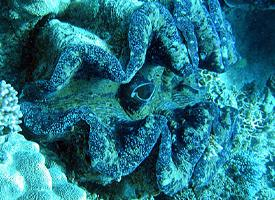
Description de l'animal
Giant clams, scientifically known as Tridacna gigas, are among the most fascinating creatures of the marine world. Native to the warm waters of the South Pacific and Indian Oceans, these mollusks are the largest living bivalves on the planet, with some individuals growing over a meter in length and weighing more than 200 kilograms. Their size and the vibrant colors of their mantles make them a spectacular sight, contributing significantly to the biodiversity and beauty of coral reef ecosystems.The mantle of the giant clam is a sight to behold, displaying a wide array of colors and patterns, from bright blues and greens to more subtle hues. These colors are not just for show; they serve a critical purpose. Embedded within the mantle are numerous symbiotic zooxanthellae, photosynthetic algae that provide the clam with essential nutrients. In return, the clam offers the algae a safe home and exposure to sunlight, creating a perfect example of mutualism where both parties benefit from the relationship.
Giant clams play a vital role in their ecosystem. They are filter feeders, drawing in water to extract plankton and other suspended particles for food, while also contributing to the water's cleanliness. Additionally, their large, calcium carbonate shells contribute to the structure and stability of coral reefs, offering shelter and protection to a variety of marine species.
Despite their imposing size, giant clams are quite harmless to humans. They are sessile creatures, spending their lives attached to the same spot on a reef once they settle as larvae. There's a myth that giant clams can trap divers with their massive shells, but in reality, they close their shells very slowly, and only as a defensive response to threats.
Reproduction in giant clams is an impressive spectacle. They are hermaphrodites, possessing both male and female reproductive organs, which allows them to produce both eggs and sperm. When the conditions are right, usually synchronized with lunar cycles or changes in water temperature, giant clams release a cloud of sperm and eggs into the water column in a process known as spawning. This simultaneous release increases the chances of fertilization.
Unfortunately, giant clams face several threats, including overharvesting for their meat and shells, habitat destruction, and the impacts of climate change. Their slow growth rate and late maturity make their populations particularly vulnerable to overfishing. Conservation efforts are underway in many parts of the world, including breeding and restocking programs, to help protect these magnificent creatures and ensure their survival for future generations.
In summary, giant clams are not only marvels of the marine world due to their immense size and striking appearance but also play a crucial role in the health and complexity of coral reef ecosystems. Their life cycle and the symbiotic relationship with zooxanthellae algae are prime examples of the interconnectedness of oceanic life. Efforts to conserve giant clams are essential in preserving the rich biodiversity of our oceans.
Nouvelles photos d'animaux
Top 10 des animaux
- Dolphin gull (Leucophaeus scoresbii)
- Japanese macaque (Macaca fuscata)
- Stone loach (Barbatula barbatula)
- Greek tortoise (Testudo graeca)
- Russian tortoise (Testudo horsfieldii)
- Galápagos tortoise (Geochelone nigra complex)
- Diana monkey (Cercopithecus diana)
- Moustached guenon (Cercopithecus cephus)
- Common flying dragon (Draco volans)
- Galápagos penguin (Spheniscus mendiculus)